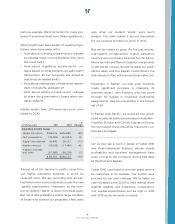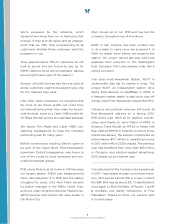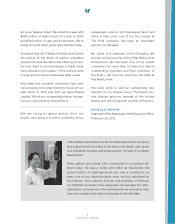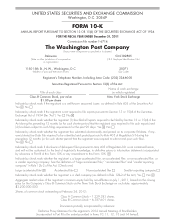Washington Post 2011 Annual Report Download - page 17
Download and view the complete annual report
Please find page 17 of the 2011 Washington Post annual report below. You can navigate through the pages in the report by either clicking on the pages listed below, or by using the keyword search tool below to find specific information within the annual report.The Kaplan Commitment, along with generally lower demand among other factors, has resulted in a 37% decline in
enrollments in 2011. Kaplan estimates that without the Kaplan Commitment, this decline would have been approximately
20% in 2011. Kaplan also estimates that revenue for 2011 would have been approximately $63 million higher if the
Kaplan Commitment had not been implemented.
For those first-time students enrolled to date under the Kaplan Commitment, the attrition rate during the risk-free period has
been approximately 27%, of which about 59% is due to Kaplan’s dismissal of students from the program because of the
students’ lack of academic progress during the period, and the remainder is due to students who have elected not to
continue their studies. Given that the Kaplan Commitment program has only been in place for a short period of time,
Kaplan is unable to estimate with confidence to what degree the program will cause student retention patterns to differ
from historical levels. However, based on limited preliminary data, it appears that most of the historical early term attrition
has been accelerated into the commitment period, having the desired effect of providing these students with a risk-free
trial period and ultimately improving student outcome results for the institution. Nonetheless, there is no guarantee that the
program will be successful in reducing cohort default rates.
Recent Rulemaking Initiatives. The DOE published final regulations on October 29, 2010, addressing various
program integrity topics, that went into effect on July 1, 2011. The topics covered in the final regulations include, but are
not limited to, the following:
• Revisions to the incentive compensation rule, see Incentive Compensation section below;
• Expansion of the notice and approval requirements for adding new academic programs and new reporting and
disclosure requirements for academic programs;
• Revision and expansion of the types of activities that are deemed a “substantial misrepresentation” and the ability of
the DOE to enforce the provisions;
• Requirement that states authorize institutions and set forth certain minimum requirements to obtain such authorizations,
see State Authorization section below;
• Limiting agreements between related institutions;
• Defining a “credit hour”;
• Administration of ability-to-benefit examinations;
• Student attendance requirements;
• Proof of high school graduation;
• Verification of information included on student aid applications;
• Satisfactory academic progress;
• Retaking coursework;
• Return of Title IV funds; and
• Disbursements of Title IV funds.
The implementation of the final regulations has required KHE to change its practices to comply with these requirements,
which has increased the risk of incorrect application of U.S. Federal financial aid and institutional administrative costs.
Gainful Employment. In June 2011, the DOE issued final regulations that tie an education program’s Title IV eligibility
to whether the program leads to gainful employment. The regulations define an education program that leads to gainful
employment as one that complies with the following gainful employment metrics as calculated under the complex formulas
prescribed in the regulations: (1) the average annual loan payment for program graduates is 12% or less of annual
earnings; (2) the average annual loan payment for program graduates is 30% or less of discretionary income, generally
defined as annual earnings above 150% of the U.S. Federal poverty level; and (3) the U.S. Federal loan repayment rate
must be at least 35% for loans owed by students for attendance in the program regardless of whether they graduated.
If a program fails all three of the gainful employment metrics in a single U.S. Federal fiscal year, the Department requires the
institution, among other things, to disclose to current and prospective students the amount by which the program under-
performed the metrics and the institution’s plan for program improvement, and to establish a three-day waiting period before
students can enroll. Should a program fail to achieve the metrics twice within three years, the Department requires the
institution, among other things, to disclose to current and prospective students that they should expect to have difficulty
repaying their student loans; that the program is at risk of losing eligibility to receive U.S. Federal financial aid; and that
transfer options exist, including providing resources to students to research other education options and compare program
costs. Should a program fail three times within a four-year period, the DOE would terminate the program’s eligibility for U.S.
2011 FORM 10-K 5
























